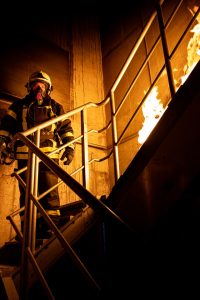Framing is one of the most important steps in the building process; it is the frame that sets the stage for overall project results. Without a sturdy frame and a reliable foundation, a building will crumble – just like a house of cards.
While some buildings, like residential homes, are commonly framed with wood, you’ll now find that cold-formed steel metal studs are making a huge impact on the residential market. Even though wood can certainly be a reliable option for residences and small buildings, keep in mind that wood simply isn’t a viable option for commercial or large buildings.
Cold-formed steel framing continues to be a trustworthy option for not only the big projects, but also for the small residential ones. When used properly, cold-formed steel can not only provide a strong framing solution, it can solve a multitude of framing problems. This framing material can be used in curtain wall applications, and is also strong enough to be load bearing and utilized as the primary structure.
We’ve put together 7 reasons why you should consider cold-formed steel to satisfy the framing needs on your next project.
1. Spend Less
Maybe what’s holding you back from using cold-formed steel (also known as light steel framing) is the initial cost. However, you must look at the big picture, because metal studs can provide you with cost savings for the entire life of the building.
Building owners will vouch that cold-formed steel saves big money in terms of insurance costs, upkeep, construction costs, time, energy-efficiency, pest protection, and more. Some savings will be immediate during construction, and some savings will pay off over time.
2. Durable Material
Steel is one of the most durable materials out there. When you choose cold-formed steel framing as your material, you get a stable frame that will hold up against the elements.
When compared to other materials, many of the other framing materials have considerable weaknesses. For example, concrete shrinks and can form cracks related to shrinking. Brick tends to swell when moisture is present. And, wood not only can shrink with moisture, it also has a tendency to warp, crack, splinter, or rot. Wood can also be destroyed by termites, pets and mold. While other materials have a reputation for deterioration over time, cold-formed steel does not.
Structural engineers, in particular, know and understand how cold-formed steel can best be incorporated into the design of your structure for the most durability and resilience overall.
3. Time Saver
Cold-formed steel is often known in the industry as the ultimate time-saver. Since it is not heat-formed, or a material that is negatively affected by cold or adverse weather, it can typically be used for construction any time during the year.
With cold-formed steel, everything can be personalized too – including custom shapes and sizes. While panelizing continues to be an ideal time-saver for cold-formed steel framing projects, installers also have the flexibility to “assemble as you go” with this material saving time waiting on material delivery.
4. High Tensile Strength
It’s well known that steel is one of the strongest materials on the market when it comes to its load-bearing and weight ratios. This information is available for further review from the American Iron & Steel Institute, which monitors the use of steel and also sets forth guidelines on the material.
Steel in general is designed to stand up to heavy-duty use while still providing the ultimate amount of safety and protection. Another reason cold-formed steel is so attractive as a framing material is its ability to be pliable and strong. The various bends, folds, and stiffeners that are incorporated into the steel studs and connectors increase the strength, making it the most sought-after framing material on the market today.
Still not convinced that cold-formed steel is the better framing material? Let me give you another fact… cold-formed steel is up to 7 times stronger than wood.
5. Fire Resistant
Steel is fire-resistant. This means that it is non-combustible, and will not burn or feed a fire. Whereas, wood is a material that can quickly burn and add fuel to an already devastating fire.
Cold-formed steel can protect the structure and potentially reduce the likelihood of the fire spreading. Projects that are built with cold-formed steel framing members and connectors see additional savings in insurance costs and the elimination of expensive sprinkler systems.
6. Inorganic material is best
We all know wood can easily be susceptible to termites, mice and other forms of pestilence that can quickly deteriorate the quality and reliability of the framing material. Wood can also hold mold and other fungus that can negatively impact the materials and the structure.
Steel does not mold, and is also not susceptible to pests or vermin. This is directly related to steel being an inorganic material.
7. Energy-Efficiency
Energy-efficiency is relative to the structure itself but also to the way that the materials are made. For starters, cold-formed steel does not use any heat or emissions to form the framing shapes. It is made with galvanized sheets of steel, and is an economically-friendly material.
As the demand for eco-friendly products continues to increase, the steel industry continues to take action to reduce their footprint. They have effectively reduced both C02 emissions and the energy intensity of the production process.
Plus, by simply using steel owners effectively reduce energy costs within the building.
Conclusion
Whether you need to build an infill wall, or an entire 6-story hotel – take a closer look at all the benefits of cold-formed steel. It can easily satisfy not only requirements for secondary framing, but is also commonly used as the primary structure on mid-rise projects with a repeating floor plan.
Cold-formed steel is superior to other framing materials on the market, and we trust it will be able to also satisfy your framing needs!



Recent Comments